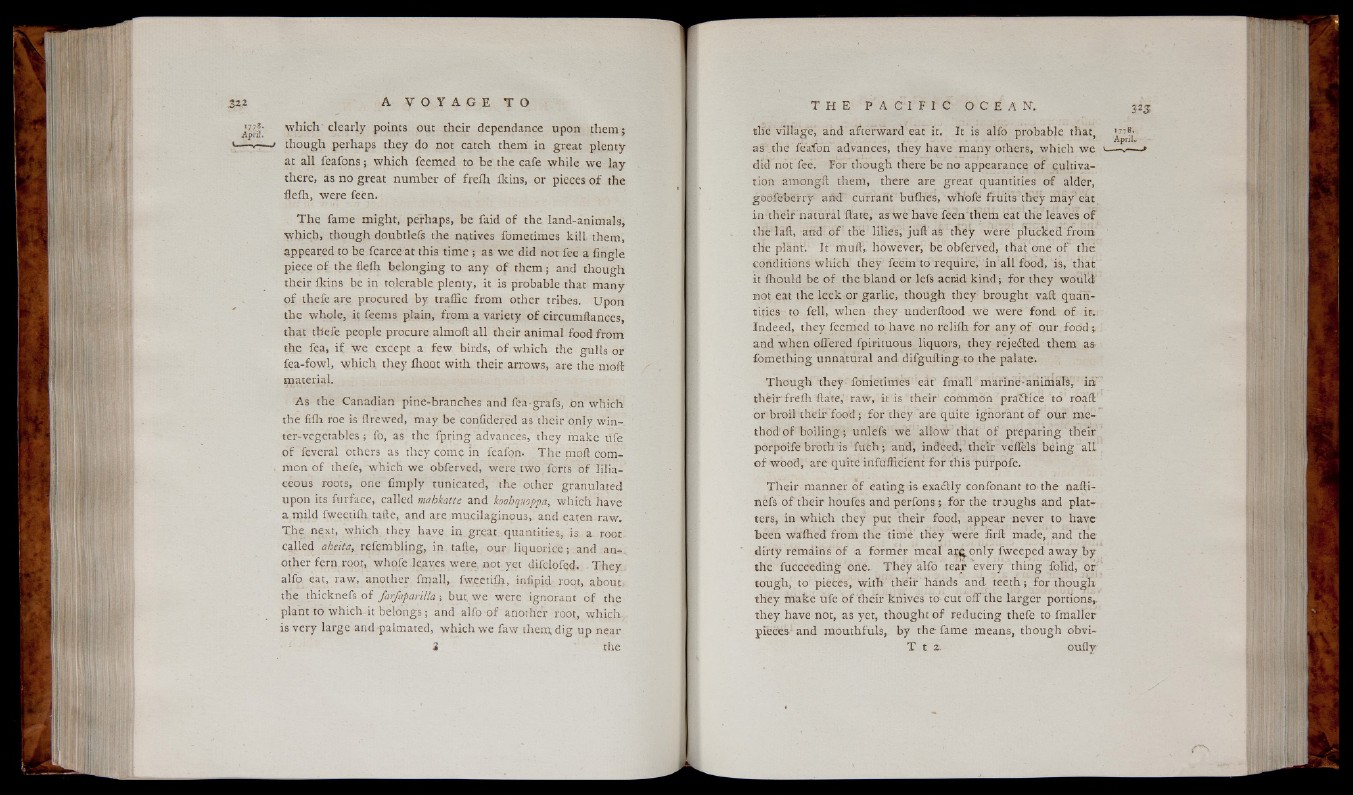
w h ich ' clearly points out their dépendance upon them ;
though perhaps they do not catch them in great plenty
at all feafons ; which feemed to be the cafe w h ile we la y
there, as no great number o f fre ili ikins, or pieces o f the
flefli, were feën.
T h e fame might, perhaps, be faid o f the Iand-animals,
w hich, though doubtlefs the natives fometimes k ill them,
appeared to be fcarce at this time ; as we did not fee a Angle
piece o f the fleih belonging to any o f them ; and though
their lidns be in tolerable plenty, it is probable that many
o f thefe are procured by traffic from other tribes. Upon
the whole, it feems plain, from a variety o f circumftances,
that thefe people procure almoft all their animal food from
the fea, i f w e except a few birds, o f w hich the gu lls or
fea-fowl, w h ich they Ifio.ot w ith their arrows, are the moll
material.
As the Canadian pine-branches and fea-grafs, fin which
the fifh roe is flrewed, ma y be confidered as their only win-
ter-vegetables ; fo, as the fpring advances, they make life
o f feveral others as they come in feafon. T h e moil common
o f thefe, which we obferved, were two forts o f lilia ceous
roots, one limply tunicated, the other granulated
upon its furface, called mahkatt e and koohquoppa, w hich have
a mild fweetilh tafte, and are mucilaginous, and eaten raw.
The next, which they have in great, quantities, is a. root
called aheita, refembljng, in tafte, our liquo rice ; and an-,
other fern root, whqfe leaves were, not yet difclofqd. They,
alfp. eat, raw, another fmall, fweetilh, inftpid root, about,
the thicknefs o f farfaparilla -, but. we were ignorant o f the
plant to which it belongs ; and a i fo o f another root, which,
is very large and -palmated, w h ich w e faw them, dig up near
2 the
thé villa g e , and afterward eat it. It is alfo probable that,
as .the feafon advances, they have many others, which we 1---- .—■
did not fee, For though there be no appearance o f cultivation
amongft them, there are grea t quantities o f alder,
goofeberry and' currant bufhës, wh’ofe fruits they nifty cat
in their natural Hate, as We have feen them eat the leaves o f
the laft, and o f the lilies, juft as they w e re 'p lu ck ed from
the plant; It mufti however, be obfefved, that one o f ' thé"
conditions which they feem to require) in all food, is, that
it ihould be o f the bland or lefs acrid kin d; for they would
not eat the leek or garlic, though they brought vaft quantities
to fell, when they underftood .w è were fond o f it.,
Indeed, they feemed to have no relifh for any o f our food
and when offered fpirituous liquors, they rejected them as
fomething unnatural and difgufting to the palate.
T h o u g h th e y fonietinted " e à f fmall marine-animals, in "
their fre lh Hate,‘ raw, it is their' common practice to roaft
or broil their food ; for they are quite ignorant o f our method
o f b o ilin g ; unlefs w e allow that o f preparing their
porpôife broth is fu c h ‘ and, indeed, their vëlÎèls be in g a ll'
o f wood, are quite infufficient fo r this purpofe.
T h e ir manner o f eating is exadtly confonant to* the nafti-
nèfs o f their houfes and perfons ; for the troughs and platters,
in which they put their food, appear never to have
been warned from the time the y were firft made, and the
dirty remains Of a former meal ar^,only fweeped away b y
the fucceeding one. T h é y alfo tear every thin g folid, o r
tough, to pieces, with their hands and teeth ; for though
they make fife Of their knives to cut o ff the large r portions,,
they have not, as yet, thought o f reducing thefe to fmaller
pieces- and mouthfuls, by the- fame means, though obvi-
T t a oufly